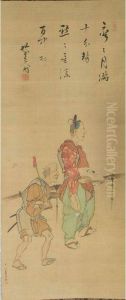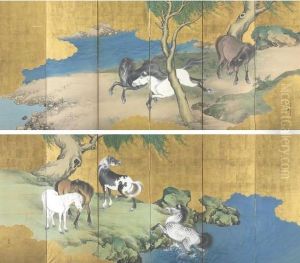Yokoyama Kazan Paintings
Yokoyama Kazan was a prominent Japanese painter, poet, and intellectual of the late Edo period, who is particularly known for his masterful landscape paintings and portraits. Born on October 9, 1784, in Kyoto, Japan, Kazan was originally named Yokoyama Tanesuke. He later changed his name to Kazan, which he is best known by today.
Kazan was born into a samurai family, which provided him a classical education that included training in the arts and literature. He was particularly influenced by Chinese and Japanese literati painting traditions. Despite his samurai roots, Kazan chose to pursue a career as a painter and became a student of the influential Maruyama-Shijo school of painting, studying under Goshun Matsumura. Kazan's artistic style was a blend of the naturalistic Maruyama school and the more expressive Shijo school style.
During his lifetime, Kazan held various positions, including working for the Kyoto city government. However, he is most celebrated for his artistic contributions. His work is characterized by its delicate use of color and fine brushwork, with a strong focus on the beauty of the natural world. In addition to landscapes, he also painted flowers, birds, and human figures, often imbuing them with a sense of poetic sentiment.
Kazan's life was not without turmoil. He was deeply affected by the social and political changes happening in Japan at the time, as the country grappled with the pressures of Western influence and internal strife. His interest in Western knowledge and art, which included the use of Western perspective in his works, eventually led to suspicion and scrutiny by the authorities. In 1834, following the discovery of a letter he wrote that was critical of the shogunate’s policies, Kazan was placed under house arrest.
This period of confinement took a toll on Kazan’s health and spirit. Despite the harsh conditions, he continued to produce art, and some of his most poignant and reflective works come from this late stage of his life. Tragically, Yokoyama Kazan's life came to a premature end when he took his own life on August 23, 1837, perhaps in part due to the pressures he faced during his house arrest.
Today, Yokoyama Kazan's works are highly regarded and can be found in various museums and collections in Japan and around the world. His legacy lives on as an artist who captured the beauty of the natural world while also engaging with the intellectual and social issues of his time.

